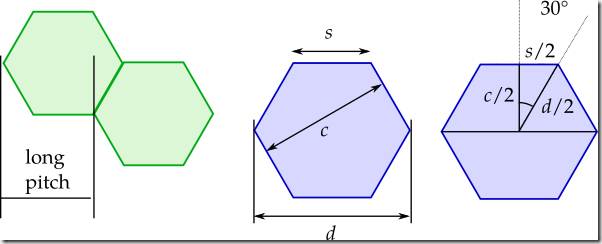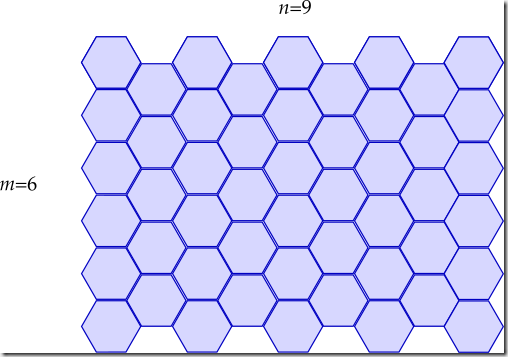Look at the right-most figure in diagram. The small triangle defines the all the major dimensions of the hexagon. Assuming the user measures the edge-to-edge dimension $c$, he or she can calculate the rest of the measurements. A simple right-triangle expression gives the relationship between $s/2$ and $c/2$, and is readily solved for $s$ in terms of $c$,
$$ \frac{s}{2} = \frac{c}{2}\tan\left(30°\right) $$
$$ s = c\tan\left(30°\right) = c\frac{\sqrt{3}}{3}. $$
Similarly, the Pythagorean formula gives the relationship between $c$ and the two other dimensions,
$$ d = \sqrt{ c^2 + s^2} = \frac{2c}{\sqrt{3}}.$$
Simplifying this equation by substituting for $s$ into the previous equation and simplifying produces
$$ \text{long pitch} = s + \frac{d-s}{2} = \frac{s+d}{2} = \frac{\sqrt{3}}{2}c \approx 0.87c. $$
A blanket $n$ hexagons by $m$ hexagons will be approximately
$$
0.87c\,n \times m\,c, $$
where the $m$ and $n$ dimensions are as shown in the next figure.
If a blanket will be wider at the ends, as shown in the figure, then $n$ will be odd. The total number of hexagons will then be
$$ \text{number of hexagons} = m \frac{n+1}{2} + (m-1)\frac{n-1}{2}. $$
In the example there are $(n+1)/2=5$ tall columns and $(n-1)/2=4$ short columns. So there are 6×5=30 hexagons in tall columns and (6-1)×4=20 hexagons in the short columns, or 50 hexagons overall. Using equation for blanket size and assuming $c=10$ inches, the approximate dimensions of the finished blanket are 9×10×0.87 by 6×10, or 78.3 by 60 inches.


